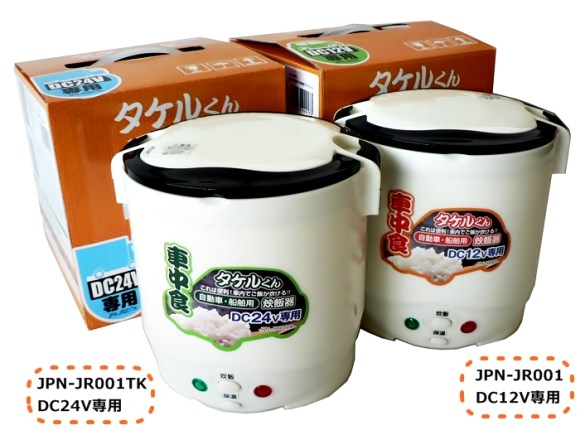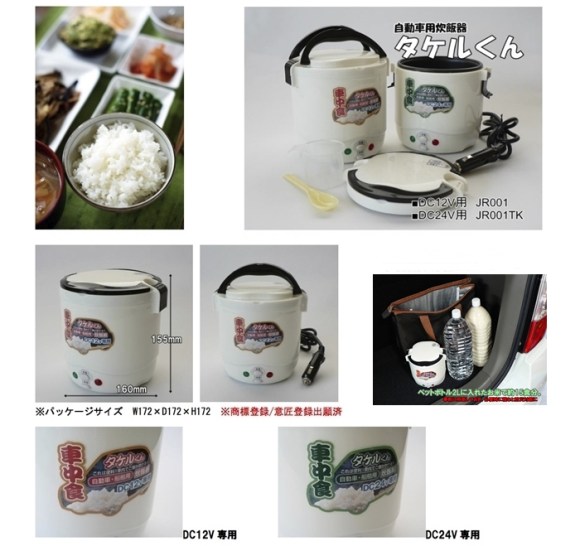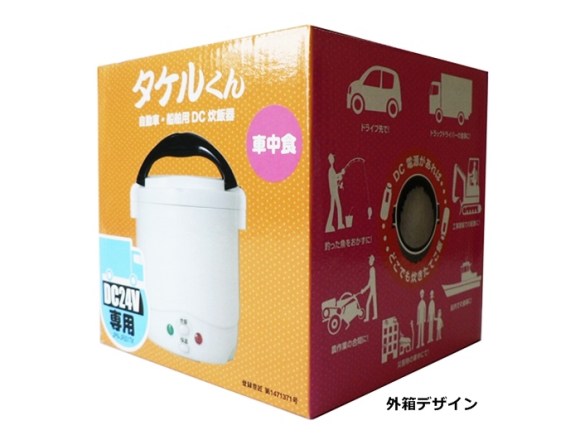
In the never-ending debate about which country makes the best cars, it’s common to derogatorily refer to a Japanese automobile as a “rice rocket,” “rice burner,” or “rice runner.” Really anything with rice.
But with a new product from Saitama-based company JPN, you can own that insult, and turn it into a positive.
JPN stands for Japan Professional Network, and befitting a company with such a vague-sounding name, it’s a little hard to find a common theme in their product line-up. Aside from interior paints and leather smartphone covers, JPN also sells car accessories such as door handle covers and cell phone chargers.
With mobile phones covered, JPN’s designers moved on to another machine near and dear to the Japanese way of life: the rice cooker.
Called Takeru-kun, JPN’s rice cooker plugs into the 12-volt electrical socket found in any passenger car. With compact dimensions of 160 mm (6.3 in) across by 155 mm (6.1 in) tall, the Takeru-kun won’t feed a whole family with one batch, but JPN claims it makes enough for two bowls of rice.
The machine isn’t any harder to use than the average suihanki rice cooker found in any Japanese home. After plugging it in, open the lid and add the rice and water. Pre-washed rice works best, of course, and JPN recommends a ratio of 1.1 parts water to one part rice. Shut the lid, hit the start button, and in about 25 minutes, the rice will done.
Although it’s technically ready to eat at that point, it’s best to let the rice sit, with the lid closed, for another 10 minutes or so. This extra steaming time will ensure that each grain is moist and fluffy, unlike the microwavable packs of rice bachelors buy from the 100-yen shop. Test testers have been fully satisfied with the results, saying that Takeru-kun’s rice comes out as tasty as the stuff they eat at home.
The standard Takeru-kun retails for 4,980 yen (US$50). A 24-volt version, usable with the larger capacity outlets on trucks and other large vehicles, is a little pricier at 5,480 yen, but cooks its rice just a little faster as well. Both models come packaged with a rice scoop.
JPN’s executive director, Nobuyuki Masuda, says the development team grappled for one year with problem of generating enough heat to properly cook rice with just 12 volts of power. Their eventual solution was to coat the Takeru-kun in insulating materials that retain as much heat as possible. This design choice has the additional benefit of helping to keep the rice warm after cooking is complete, although the machine also includes an electrically-powered function for the same purpose.
Takeru-kun is well on its way to meeting JPN’s sales target of 10,000 units in its first year. The rice cooker’s official release date was August 21, but even before that JPN had already received 3,000 preorders following the product’s announcement in June. Masuda himself was surprised by the reaction. “Honestly, we thought it would take more time for it to catch on.”
Outdoor enthusiasts are an obvious market for the product. Roasted marshmallows may be the first food that comes to mind for Americans campers, but in Japan you’re not really camping until you’ve cooked up a batch of curry, which means you’ll need some rice to go with it. Masuda says the Takeru-kun’s price point is in line with what people are willing to pay for disaster-preparedness goods as well, with some stores displaying the rice cooker alongside blankets, bottled water, and other emergency supplies.
Unfortunately, the Takeru-kun’s instructions specifically state that it is not to be used while the vehicle is in motion. This is probably for the best though, since like all rice cookers it emits a steady stream of hot vapor out of its vents while in operation, which could be just a tad distracting for motorists. So follow the directions and start your cooking after you’ve stopped your car on a flat surface. Like they say, a watched pot never boils, so we recommend using the 30 minutes or so you’ll be waiting for any of a number of traditional and necessary car-related activities, such as checking your tire pressure, reconfirming your route on the GPS, or making out in the back seat.
Sources: JPN, Nikkei Trendy Net
Images: JPN



 Rice cooker cooking: Bacon onion rice is amazingly easy, awesomely delicious
Rice cooker cooking: Bacon onion rice is amazingly easy, awesomely delicious New Japanese bowl-shaped donburi rice cooker cooks rice and toppings at the same time
New Japanese bowl-shaped donburi rice cooker cooks rice and toppings at the same time Japan’s one-person bento box-sized rice cooker can give you freshly cooked rice at the office
Japan’s one-person bento box-sized rice cooker can give you freshly cooked rice at the office This is what happens when you cook rice with coffee in your rice cooker 【Rocket Kitchen】
This is what happens when you cook rice with coffee in your rice cooker 【Rocket Kitchen】 Japanese beef bowl chain Sukiya’s 2026 Smile Box lucky bag basically pays for itself
Japanese beef bowl chain Sukiya’s 2026 Smile Box lucky bag basically pays for itself Top Japanese cosplayer Enako returns to Comiket after 6 years, creates mayhem with admirers
Top Japanese cosplayer Enako returns to Comiket after 6 years, creates mayhem with admirers Dragon Quest Burgers and Slime drinks are coming to McDonald’s Japan【Video】
Dragon Quest Burgers and Slime drinks are coming to McDonald’s Japan【Video】 Rakuten randomly offers 58 New Year’s osechi feasts in Japan, but did we get a star or a dud?
Rakuten randomly offers 58 New Year’s osechi feasts in Japan, but did we get a star or a dud? Things get heavy with the Gold Lucky Bag from Village Vanguard
Things get heavy with the Gold Lucky Bag from Village Vanguard 9 middle-aged Japanese men try putting on their own makeup
9 middle-aged Japanese men try putting on their own makeup Nearly one in ten young adults living in Japan isn’t ethnically Japanese, statistics show
Nearly one in ten young adults living in Japan isn’t ethnically Japanese, statistics show The Purple Lucky Bag from Village Vanguard is an extra-large waste of money
The Purple Lucky Bag from Village Vanguard is an extra-large waste of money Private booths are coming to Japan’s Shinkansen bullet trains even sooner than we’d thought【Video】
Private booths are coming to Japan’s Shinkansen bullet trains even sooner than we’d thought【Video】 More JSDF recruitment posters get a moe makeover in Ibaraki
More JSDF recruitment posters get a moe makeover in Ibaraki Starbucks Japan ready to get Year of the Horse started with adorable drinkware and plushies【Pics】
Starbucks Japan ready to get Year of the Horse started with adorable drinkware and plushies【Pics】 Hayao Miyazaki says Happy New Year to Studio Ghibli fans with new art for Year of the Horse
Hayao Miyazaki says Happy New Year to Studio Ghibli fans with new art for Year of the Horse Cup Noodle tries an authentic Jiro-style ramen, but something’s not quite right
Cup Noodle tries an authentic Jiro-style ramen, but something’s not quite right The best Starbucks Japan Frappuccinos we want to drink again in 2026
The best Starbucks Japan Frappuccinos we want to drink again in 2026 We revisited Sweets Paradise after a decade to see if Japan’s dessert buffet still delivers
We revisited Sweets Paradise after a decade to see if Japan’s dessert buffet still delivers That time Seiji called JASRAC to ask why he didn’t get paid royalties for his song being on TV
That time Seiji called JASRAC to ask why he didn’t get paid royalties for his song being on TV We found possibly the quietest Japanese-style hotel in Tokyo’s bustling Shinjuku district
We found possibly the quietest Japanese-style hotel in Tokyo’s bustling Shinjuku district Pizza Hut Japan’s hot lucky bags are perfect for a New Year’s pizza party
Pizza Hut Japan’s hot lucky bags are perfect for a New Year’s pizza party Japan’s oldest largetooth sawfish in captivity back on display in Mie Prefecture
Japan’s oldest largetooth sawfish in captivity back on display in Mie Prefecture 7-Eleven Japan starts new temporary luggage storage service in over 300 branches
7-Eleven Japan starts new temporary luggage storage service in over 300 branches Disillusionment at Tsukiji’s tourist-target prices led us to a great ramen restaurant in Tokyo
Disillusionment at Tsukiji’s tourist-target prices led us to a great ramen restaurant in Tokyo Starbucks teams up with 166-year-old Kyoto doll maker for Year of the Horse decorations【Photos】
Starbucks teams up with 166-year-old Kyoto doll maker for Year of the Horse decorations【Photos】 Tokyo considering law requiring more trash cans following litter increase in heavily touristed area
Tokyo considering law requiring more trash cans following litter increase in heavily touristed area Tokyo’s Tsukiji sushi neighborhood asks tour groups to stay away for the rest of the month
Tokyo’s Tsukiji sushi neighborhood asks tour groups to stay away for the rest of the month Tokyo event lets you travel back in time, for free, to celebrate 100 years since Showa era start
Tokyo event lets you travel back in time, for free, to celebrate 100 years since Showa era start Japan may add Japanese language proficiency, lifestyle classes to permanent foreign resident requirements
Japan may add Japanese language proficiency, lifestyle classes to permanent foreign resident requirements Sanrio theme park in Japan announces plans to expand into a Sanrio resort
Sanrio theme park in Japan announces plans to expand into a Sanrio resort Stamina-destroying “Paralysis Noodles” are Tokyo’s newest over-the-top ramen innovation
Stamina-destroying “Paralysis Noodles” are Tokyo’s newest over-the-top ramen innovation Survey asks foreign tourists what bothered them in Japan, more than half gave same answer
Survey asks foreign tourists what bothered them in Japan, more than half gave same answer Japan’s human washing machines will go on sale to general public, demos to be held in Tokyo
Japan’s human washing machines will go on sale to general public, demos to be held in Tokyo Japan’s deadliest food claims more victims, but why do people keep eating it for New Year’s?
Japan’s deadliest food claims more victims, but why do people keep eating it for New Year’s? We deeply regret going into this tunnel on our walk in the mountains of Japan
We deeply regret going into this tunnel on our walk in the mountains of Japan Studio Ghibli releases Kodama forest spirits from Princess Mononoke to light up your home
Studio Ghibli releases Kodama forest spirits from Princess Mononoke to light up your home Major Japanese hotel chain says reservations via overseas booking sites may not be valid
Major Japanese hotel chain says reservations via overseas booking sites may not be valid Put sesame oil in your coffee? Japanese maker says it’s the best way to start your day【Taste test】
Put sesame oil in your coffee? Japanese maker says it’s the best way to start your day【Taste test】 No more using real katana for tourism activities, Japan’s National Police Agency says
No more using real katana for tourism activities, Japan’s National Police Agency says Starbucks Japan reveals new sakura drinkware collection, inspired by evening cherry blossoms
Starbucks Japan reveals new sakura drinkware collection, inspired by evening cherry blossoms Updated cherry blossom forecast shows extra-long sakura season for Japan this year
Updated cherry blossom forecast shows extra-long sakura season for Japan this year Let’s cook this jet-black chicken in the rice cooker and see what happens【SoraKitchen】
Let’s cook this jet-black chicken in the rice cooker and see what happens【SoraKitchen】 New cooking gadget turns your kitchen into a Japanese izakaya pub all by itself【Photos】
New cooking gadget turns your kitchen into a Japanese izakaya pub all by itself【Photos】 Super-cheap, super-convenient rice-cooking mug is a new kitchen gadget all-star from 3 Coins
Super-cheap, super-convenient rice-cooking mug is a new kitchen gadget all-star from 3 Coins How much more expensive is it to use microwave rice packs instead of cooking/freezing your own?
How much more expensive is it to use microwave rice packs instead of cooking/freezing your own? Rice-flavor popsicles from Garigari-kun are Japan’s newest head-scratching sweet treats
Rice-flavor popsicles from Garigari-kun are Japan’s newest head-scratching sweet treats New Japanese rice cooker cuts carbohydrates at the push of a button
New Japanese rice cooker cuts carbohydrates at the push of a button Japan goes beyond rice cookers with new curry rice cooker, the kitchen gadget we need right now
Japan goes beyond rice cookers with new curry rice cooker, the kitchen gadget we need right now Minimal effort, loads of flavor: Make juicy roast beef in your rice cooker with vacuum cooking!
Minimal effort, loads of flavor: Make juicy roast beef in your rice cooker with vacuum cooking! Japan’s one-person bento box-sized rice cooker gets double-decker version that cooks side dishes too
Japan’s one-person bento box-sized rice cooker gets double-decker version that cooks side dishes too Cook up an easy campsite feast inside your home with the “Ramen Cooker”
Cook up an easy campsite feast inside your home with the “Ramen Cooker” We try cooking lots of things with Japan’s double-decker one-person bento box-sized rice cooker
We try cooking lots of things with Japan’s double-decker one-person bento box-sized rice cooker Man cooks rice, stir-fried noodles in convenience store parking lot before starting police chase
Man cooks rice, stir-fried noodles in convenience store parking lot before starting police chase Did you know your rice cooker is also a ramen rice cooker?【SoraKitchen】
Did you know your rice cooker is also a ramen rice cooker?【SoraKitchen】 Rice cooker oden: Quick, cheap, and delicious
Rice cooker oden: Quick, cheap, and delicious How to cook rice in a Ziploc container【SoraKitchen】
How to cook rice in a Ziploc container【SoraKitchen】 Chicken McNugget rice cooker rice — Can it beat KFC rice cooker rice?【SoraKitchen】
Chicken McNugget rice cooker rice — Can it beat KFC rice cooker rice?【SoraKitchen】
Leave a Reply